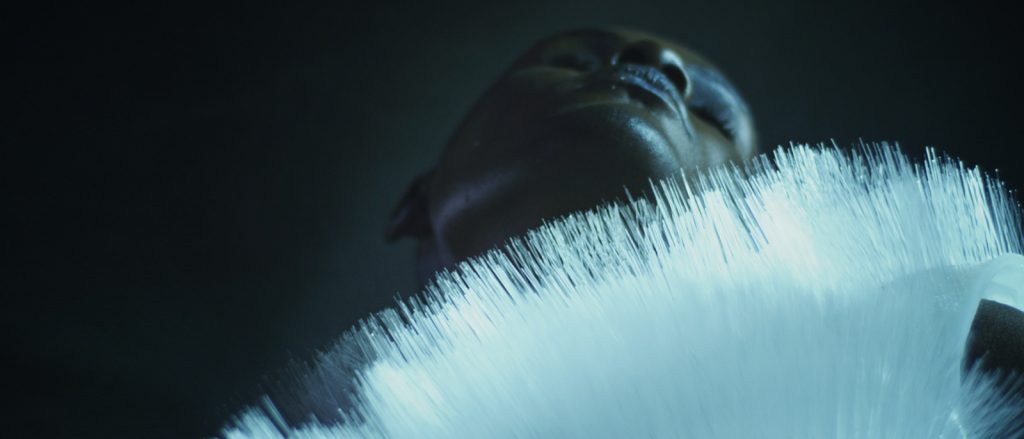You may have come across the piece BodyScape during our Look Forward FashionTech Festival exhibition… Today on the blog, we introduce you to the artist behind this chef-d’oeuvre, and many other: Behnaz Farahi.
“Behnaz, could you tell us more about who you are, what you do and what led you there?
I am a designer based in Los Angeles, and I work in the intersection of fashion, architecture and interaction design. I was trained as an architect, and currently completing my PhD in Media Art at the University of Southern California (USC) in which I am exploring of the potential of interactive environments and their relation to the human body, ranging from scale of body and the world of fashion to architectural scale. In particular I am interested in the integrated application of material behavior, and implementation of emerging technologies in contemporary art/architecture/fashion practice. I have an Undergraduate and two Masters degrees in Architecture one from USC and one from Shahid Beheshti University in Iran.
Your chef-d’oeuvre Bodyscape, that we exposed during our Look Forward Fashion Tech Festival last June, mixes sciences, technology and fashion in a really poetic way. Do you think that, in the near future, clothes will enable us knowing ourselves better, both emotionally and physiologically?
I hope fashion and technology will merge in a more poetic way. I also think recent advances in wearable and fashion technologies are able to change the notion of our bodies by allowing them to become augmented, enhanced and expanded in terms of their functionality, both emotionally and physiologically.
What becomes clear is that human beings, through the very ‘plasticity’ of the brain itself, can absorb these technological garments as an extension of the body itself, and as a conduit for engaging with the external world. Therefore, this would inevitably change the notion of fashion to an ultimate extension of one’s body in which technology, human body and fashion are in a symbiosis relationship with one another.
Was it difficult for you sourcing the necessary scientific data and materials to realize your different FashionTech pieces?
Well, I have learnt electronics and physical computing on my own, when I was an architecture student. Throughout years I have developed skill sets for the type of work I do. Now I am co-teaching and conducting workshops on various topics including algorithmic/generative design, 3D printing, wearable computing, physical computing and even use of KUKA industrial robotic arm. After developing various projects, now I have had an opportunity to gather a team of people including engineers who are interested in collaborating on these types of work, so it is actually easier these days.
3D Printed helmet which moves and illuminates according to brain activity – Credit : Synapse by Behnaz Farahi
You’ve been using 3D printing for many of your creations: why choosing this material?
3D printing has revolutionized various design fields including fashion, architecture, industrial design and so on. I am particularly interested in exploration of this tool to not only produce complex geometries inspired by natural morphologies but also to develop new shape-changing, soft and dynamic materials which can be applied in fashion or architecture.
We can now 3D print incredibly small objects at a 16 micron resolution which means that in our design process we can engage with the human body at almost the scale of half of red blood cell (approx. 8 microns in width). By defining the material properties at a micro scale we can also inform their behaviors at a macro scale.
This is already an exciting opportunity!
You not only create Fashion pieces, but you also work on technologically advanced architecture projects. Do you see a correlation between both worlds?
Yes! Of course! The bottom line is human body and the relationship between the body and architecture has a long history itself. From Vitruvius onwards, there have been attempts to relate buildings to the proportions of the human figure.
More recently, the connection between the body and architecture has developed into an interest in the fashion industry among architects, as in the “Skin + Bones: Parallel Practices in Fashion and Architecture” exhibition (Museum of Contemporary Art, Los Angeles, 2007), which drew extensively on architects designing wearables. Since then, there has been a veritable explosion of architects working in the realm of fashion—largely, but not exclusively operating through 3D printing technologies. Architects such as Neri Oxman, Philip Beesley and many more have collaborated with figures within the fashion industry, such as Iris van Herpen.
In fact I am co-editing an issue of Architectural Design (Wiley) on topic of “Body Architecture” coming out in November 2017.
In your opinion, what does the FashionTech scene needs to go forward?
This is not an easy question. I am particularly interested in shape changing, dynamic behaviors in fashion in order to explore how these behaviors can serve as an interface with the world around. From this perspective, I think the future of fashion lies its promise to be shape and color changing in order to address psychosocial issues of the world we occupy.

We heard about a new creation called “Opale”… Could you tell us more about it?
Opale is a custom-made fashion item, which integrates pneumatic soft robotics and facial tracking technology. It is equipped with a camera that can detect a range of facial expressions, and an interactive system that can respond accordingly. For example, Opale can respond to ‘anger’ by agitated movements, or to ‘surprise’ by bristling, in order to influence social interaction. Composed of a forest of fiber optics embedded in silicon. This outfit is inspired by animals, whose fur bristles when under threat, or who purr when stroked. Here is a movie and some more information on the project.”
We would like to thank Behnaz Farahi for sharing her point of view on FashionTech with Look Forward, and we hope to have the opportunity to introduce you to her work again in the future.
